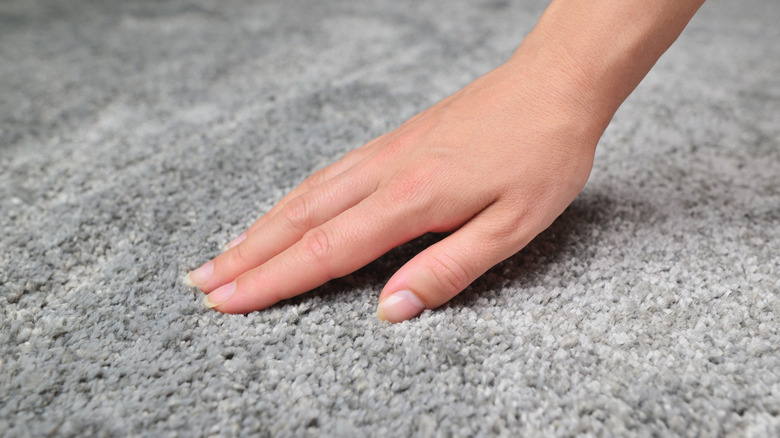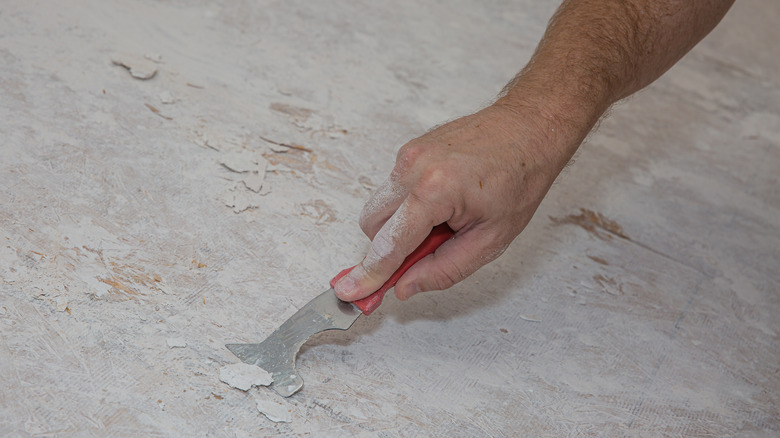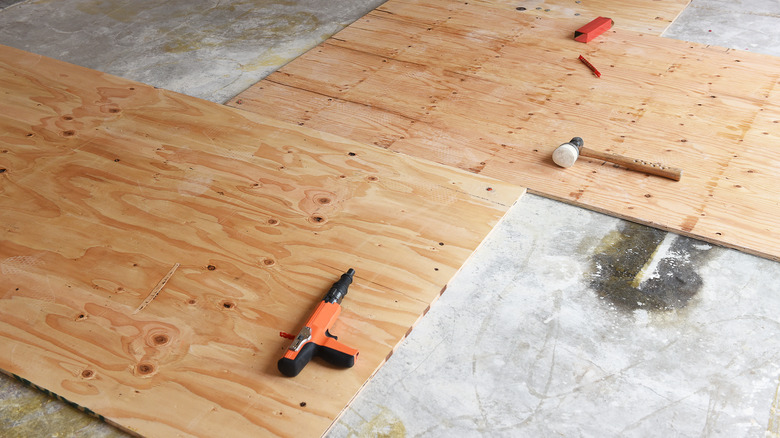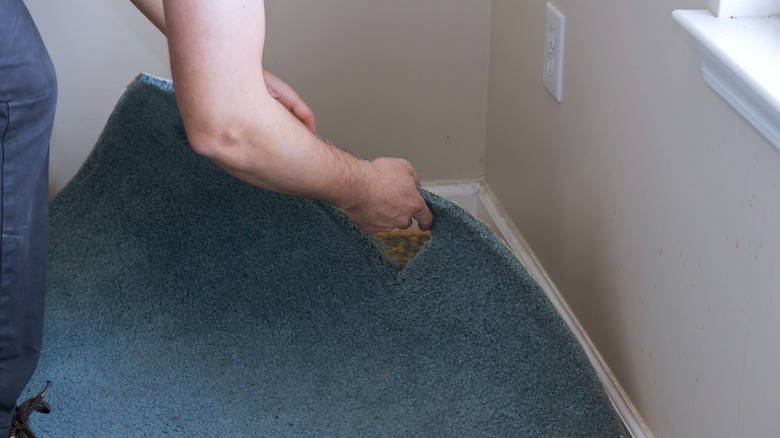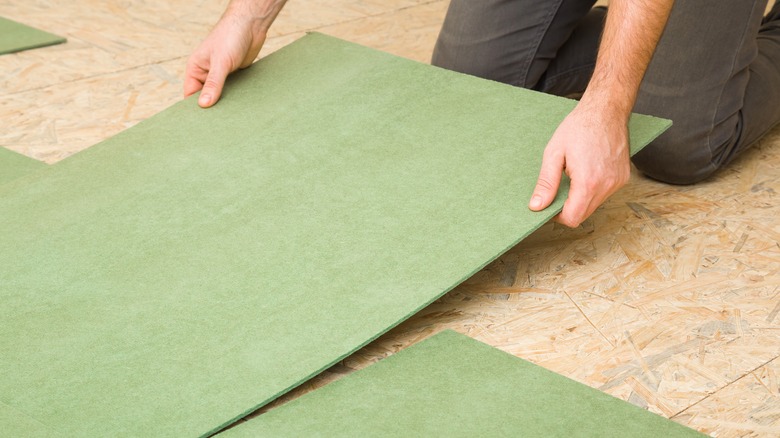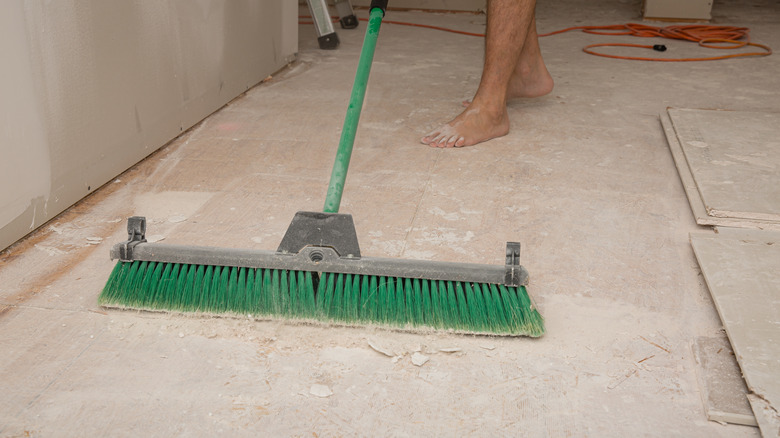How Much Does It Cost To Pull Up Carpeting In Your Home?
Carpet removal is a typical home improvement project. Refurbishing a room starts from the ground up, and the old carpet is one of the first things that need to go when embarking on a new renovation project. Fortunately, pulling up carpet is relatively inexpensive. HomeGuide reports that removal (including hauling and disposal) costs $1 to $2 per square yard. However, more in-depth removal procedures, including removing carpet from stairs or breaking up a glue bond, can increase the overall cost to as much as $5 per square yard.
Carpet removal per room averages between $37 and $183, but the task doesn't end when the floor is clear of old carpeting. To complete the transformation, you'll need to source and install a new floor covering that fits better with the aesthetic that you're trying to create in the room. Carpeting starts to look noticeably frayed after just three to five years, and a replacement is typically necessary anywhere from five years up to 15 years for premium carpeting with a solid care routine. Alternatively, many people opt to replace their worn-out carpets with tile, hardwood, or laminate. As you prepare to remove the carpets from your home, it's important to think about what type of floor covering you intend to replace them with.
Factors for cost
There are a number of factors that affect the overall cost of carpet removal. The installation method used to lay the flooring will play a significant role in the price, and labor costs can vary depending on the size of the job, the difficulty, and the disposal method.
Installation type
Perhaps the most important factor that affects the difficulty and resulting price is the method of installation. A carpet that was glued to the subfloor will necessitate a more complex removal process and may include the use of glue-thinning solutions. Fixr reports that contractors will need to cut away the carpeting in smaller strips, then use a combination of scraping, hot water, and chemicals to loosen the adhesive from the subfloor. Glue isn't the only fastening option though; many carpets use pins, staples, or tack strips rather than glue, and these are generally easier to remove, making for an overall less expensive job.
Geographic location
Your physical location plays a role in the cost of any home improvement task. From local regulations regarding the disposal of old material to regional cost differences in labor pricing, explains U.S. Bureau of Labor Statistics. Taking this into consideration is important when estimating the overall cost. Likewise, even if you live in a state that reports relatively low labor pricing, a remote home address can add to the expense. Fortunately, carpet removal remains a relatively inexpensive component of the flooring equation, making this part of the project a relatively low costing task regardless of local pricing considerations.
Labor pricing can vary as well
Different carpet installers and removers charge different rates for their services. Therefore, gathering a few quotes from local carpet removal services is a good idea. Some companies will have a minimum job price while others may offer an hourly rate, notes HomeGuide. This means that removing a carpet from a single, small room can often be quite expensive when compared with carpet removal from the whole house.
Additional costs
While labor and disposal costs are the only major features of a carpet removal estimate, the price can easily increase (or decrease) due to external factors like job difficulty, minimum pricing, and local regulations.
Tricky angles or corners
Removing carpeting from oddly-shaped rooms with difficult working conditions can have an effect on the total job price. Spaces that include stairs, raised platforms, extreme temperatures, or the need for increased care around delicate or expensive features, for instance, are likely to cause a change in the price structure. It's best to speak with your contractor ahead of the start date in order to avoid any surprises for both parties.
Consider the type of new flooring
In reality, the cost to remove existing carpeting is only the first step of a remodeling project. Those taking out a carpet are almost always doing so to make room for a new type of flooring. While other flooring surfaces can be carpeted, planked, or tiled over, HomeGuide notes that carpet must always be removed first.
While many homeowners may simply be looking to replace an existing carpet with a new layer of the same material, there are many alternative choices to add a new and vibrant look. Regardless of your choice, pulling up the old carpet is only the first step in this process. The subfloor will then need to be correctly prepared for its now covering, which can expensive especially if the floor is in poor condition.
Conducting the carpet removal yourself
Another great option is to complete the carpet removal without the help of a professional. Pulling up the carpet yourself will definitely save you money on the labor expense, however, you will still need to factor in the haulage and disposal. If you need to remove carpet from multiple rooms, it may be cheaper to leave it to the professionals who will be able to haul everything away in one trip.
DIY carpet removal
Removing carpeting from a room (or the whole home) by yourself is completely within the realm of possibility for most homeowners. But there are a number of considerations to be made when approaching this task yourself. First, removing carpet is certainly labor-intensive. You will need to be comfortable moving around the room on your knees, bending down, and lifting potentially heavy segments of carpeting out of the room. This Old House recommends using protective gear throughout the process, including knee pads, eye protection, and a facemask, especially if you're removing old carpeting due to an allergen buildup.
Family Handyman reports that the easiest way to remove carpeting from an area is to cut it into sections. Once you've made the initial cut, you should begin to roll it across the room, cutting to extend the slice as you go. Once you reach the other end of the room, simply lift out the roll of carpeting and remove it. Most carpets are held down by a tack strip that runs along the outer edge of the room (via Family Handyman). The choice to leave or remove this strip depends on the type of replacement you plan to install in the room. If you're sticking with carpet, it's a good idea to leave the strip in place. For tile or hardwood floors, removing the tack strip is necessary to create a seamless fit with the new material. When removing carpeting yourself, it's important to remember that the correct disposal falls to you as well. Some carpeting can emit VOCs, warns the CDC, so consulting with local regulations about the proper method of disposal is a must.
Why you need to pull up carpeting
Old carpets start to fray and bring other issues to the home once they pass their prime, and these problems only get more detrimental over time. If you're experiencing allergy issues in the home, are noticing bad odors, or are experiencing issues with mold or fungus then perhaps an old carpet is to blame, notes America's Floor Source.
New carpets spruce up a room
The visual appeal of new carpet, tile, or hardwood flooring is immense. JDog Junk Removal & Hauling suggests that new carpeting can drastically transform the look of a room, and with the combination of a low-cost installation and a DIY approach to carpet removal, you can make this alteration without too much expense.
According to Worx Toolshed, removing an old carpet from your home is also a great opportunity to repair any squeaky, rotten, or otherwise damaged sections of the subfloor. This part of the home often remains inaccessible, so taking the time to inspect and make repairs is a great way to prevent unexpected maintenance costs in the future.
Removing old carpet eliminates odors
Another important consideration when considering carpet removal is the smell. Carpet fibers effectively trap dust, animal dander, spilled liquids, and other debris, which can eventually lead to increasing odor problems. DustBusters Floor Removal reports that industrial cleaning services may offer a temporary remedy for homes that don't have overly aged carpeting or dense fiber patterns, however, this won't solve the problem forever. Removing and replacing old or heavily-stained carpeting is often the only way to eliminate odors that negatively affect the home.
Allergen issues from old carpets
As well as creating unpleasant odors, the elements that become trapped within your carpet fibers can also cause allergies to flare up. DustBusters Floor Removal notes that carpet fibers can quickly collect pet hair, pollen, dust, dirt, and mold, trapping a cornucopia of irritants within a small space. Allergic reactions, sinus, and breathing troubles make for a wholly unpleasant experience, so removing the source of these irritants is often the only practical solution.
Benefits of carpeting removal and flooring change
The benefits are numerous when it comes to removing and changing the floor covering in your home. Old carpets can affect energy levels and comfort immensely, and replacing them not only brightens up the room, but it can also improve the resale value and make for a more enjoyable home life on the whole.
Visual appeal
Removing old carpeting and installing something new is a great way to revamp the overall aesthetic of a room. The visual elements that new carpeting, or any other flooring, brings to an interior space are substantial. If you're already thinking of making additional changes to the decorative theme of your home, then tackling the floors is also a great way to start, suggests Custom Floor & Design. Rooms are physically and visually grounded by the flooring that supports the furniture, decorations, and lifestyle that live within the property. Making changes to a space to modernize or reimagine it can only go so far without committing to the floor as well.
Selling your property
Old flooring and carpets are a bane for homeowners seeking to sell their homes. Old carpets can be a big turn-off for potential buyers who might otherwise enjoy the layout or location of a home. According to iBuyer, a new flooring installation can net a return on investment of around 70%. When coupled with the increase in genuine interest in the property, removing old carpeting provides a major boost to the financial considerations of a homeowner in the process of listing their asset. Maintaining a good cleaning and replacement regimen is a great way to ensure that your home provides both a platform for comfort and is market-ready when the time eventually comes to sell up and move on to a new space.
